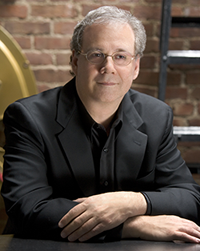On Sunday, September 28, 2014, I attended the University of Iowa’s Center for New Music’s opening concert at Riverside Recital Hall, which featured solely the music of Louis Karchin.
Louis Karchin has taught at New York University for the past 35 years. He is active as a composer and conductor in New York City. His music focuses on the exploration of harmonic worlds. His sonorities produce a distinctive timbre that becomes more apparent in his larger works. The concert Sunday evening consisted of four pieces, which followed a solo-to-ensemble, solo-to-ensemble sequence with an intermission in between. Zach Stanton, Visiting Assistant Professor at the University of Iowa, conducted both of the larger chamber ensemble pieces.
The evening concert opened with his recent composition Four Sketches, written in 2014, for solo violin, which, as Louis Karchin explains in his program notes, was written to draw attention to “the various techniques and styles of twentieth century painters.” In this work Andrew Gentzsch effectively played the role of the painter by eliciting a different technique from each movement. Of the four movements I found the third movement to be the most compelling with its transparent ternary form. The contrast from section to section was accentuated by the composer’s use of register and pizzicato. The melodic idea in the first and third sections contained a succession of high notes followed by pizzicato. In the second section the violin ventured into the low-to-mid register and added an expressive touch of vibrato to the performance. As for the other movements, the first immersed me in its exploration of timbre, leaps, and even meandering in the melody, while the second movement emphasized a half-step motive and dissonant double stops, while the fourth movement brushed me with sul ponticello.
Karchin’s Ancient Scenes, written in 2012 for soprano and six performers, was a composition that brought to mind associations, both historical and musical. The composer noted that this seven-movement work was one of very few that he considered “programmatic”, which was inspired by the works of the late Irish poet Seamus Heaney and the town of Auvillar, France. As I listened to the first movement, I found myself connecting my listening experience to two other musical compositions. The first came at the very beginning with the timpani’s percussive sounds followed by an arpeggiation in the piano. This succession of sounds reminded me of the opening of Joseph Schwantener’s …and the mountains rising nowhere. The following section also included an arpeggio played by the rest of the ensemble. The combined sonority of those instruments (flute, clarinet, violin, and cello) reminded me very strongly of the opening arpeggio of Gerard Grisey’s Vortex Temporum. When the soprano entered later in the work, I felt that my efforts to understand the English text were strongly challenged, for the text was only discernible when the accompaniment contained minimal instrumentation.
The third piece Lyrics II was for solo piano. It was a short work that began with a calm yet deliberate first movement and concluded with a second movement full of wide contrasts in register between the two hands and a characteristic motive articulated in tuplets. While I did not perceive, as he indicated in his program notes, either something “driving” or “propulsive” in the second movement, I felt that the pianist’s performance evoked a feeling of restlessness in the brief moments where I found myself forming connections to the music of Debussy and at moments where the music would wander back to the particular tuplet motive.
The Center for New Music concluded the concert with Karchin’s large chamber work Chamber Symphony, a three-movement work written in 2009. In this composition Karchin demonstrated one of his strengths as a composer: his orchestration. The transparency of his orchestration led me to form comparisons with the orchestration of Giuseppe Verdi. If I had to identify my favorite part of this concert, I would choose the second movement of this work. Unlike the other two movements of the Chamber Symphony, which were generally louder, denser, faster, and had everyone playing together, the second movement was slower, sparser in texture, more tranquil, and calmer. The ending, which ebbed away to nothing, was executed wonderfully. This combination of light texture with light instrumentation was quite rewarding for his larger chamber works, which seemed to rely considerably on everyone playing together. These aspects of this movement shaped my overall thoughts of the evening concert in a more favorable light.

